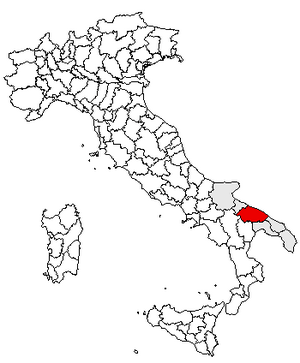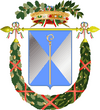Province of Bari facts for kids
Quick facts for kids
Province of Bari
Bari
|
||
|---|---|---|
|
||
 |
||
| Country | ||
| Region | Apulia | |
| Capital | Bari | |
| Area | ||
| • Total | 5,138 km2 (1,984 sq mi) | |
| Population
(2005)
|
||
| • Total | 1,594,109 | |
| • Density | 310/km2 (800/sq mi) | |
| Postal Code |
70001-70100
|
|
| Telephone prefix |
080, 0883
|
|
| ISTAT | 072 | |
| Vehicle registration | BA | |
| No. of communes | 48 | |
The Province of Bari was a province in the region of Apulia in Italy. It was located in the southern part of Italy, along the Adriatic Sea. The capital city of the province was Bari, which is also the largest city in the Apulia region.
This province was an important area for both history and trade. It had a long coastline with many ports, which helped it connect with other parts of the Mediterranean Sea. Today, the Province of Bari has been replaced by the Metropolitan City of Bari, which covers a similar area.
Contents
Exploring the Province of Bari
The Province of Bari was known for its beautiful landscapes and rich history. It stretched from the coast into the inland areas, offering a mix of beaches, rolling hills, and ancient towns.
Where is Bari Located?
The province was situated in the central part of Apulia, a region that forms the "heel" of Italy's "boot" shape. To its north were the provinces of Barletta-Andria-Trani and Foggia. To the south, it bordered the provinces of Taranto and Brindisi. The Adriatic Sea formed its eastern boundary.
What is the Capital City?
The main city and capital of the province was Bari. This bustling port city is a major economic center for southern Italy. It has a long history, with roots going back to ancient times. Bari is famous for its old town, called Bari Vecchia, which has narrow streets and historic buildings.
Famous Landmarks in Bari City
- Basilica di San Nicola: This important church holds the remains of Saint Nicholas, also known as Santa Claus. It's a popular pilgrimage site.
- Castello Normanno-Svevo: A large castle built by the Normans in the 12th century. It has been rebuilt and changed many times over the centuries.
- Petruzzelli Theatre: One of the most important opera houses in Italy, known for its beautiful architecture and grand performances.
History of the Province
The area around Bari has been settled for thousands of years. Ancient Greeks and Romans lived here, leaving behind many ruins and artifacts. Over time, different groups controlled the region, including the Byzantines, Normans, and Swabians. Each group left its mark on the culture and architecture.
From Province to Metropolitan City
In 2015, the Province of Bari was officially replaced by the Metropolitan City of Bari. This change was part of a larger reform in Italy to create new administrative areas. A metropolitan city is a bit different from a province. It gives the main city, Bari, more power to manage services for the surrounding towns. This helps with things like transportation, environmental protection, and economic development.
How Local Government Works
The Metropolitan City of Bari is led by a Mayor, who is also the Mayor of the city of Bari. There is also a Metropolitan Council, which includes representatives from the different towns within the area. This system helps ensure that decisions are made for the benefit of all the communities.
Economy and Life in Bari
The economy of the former Province of Bari was diverse. Agriculture was very important, especially the production of olives and grapes. Fishing also played a big role, thanks to the long coastline.
Main Industries
- Agriculture: Growing olives for olive oil and grapes for wine are key activities.
- Fishing: The Adriatic Sea provides a rich source of seafood.
- Trade and Shipping: The port of Bari is one of the busiest in the Adriatic, handling goods and passengers.
- Tourism: Many visitors come to explore the historic towns, beautiful coastline, and delicious food.
What is Life Like?
Life in the Bari area is often described as lively and warm. People enjoy fresh local food, especially seafood and pasta dishes. Festivals and traditions are important, often tied to religious holidays or harvest seasons. The climate is Mediterranean, with hot, dry summers and mild winters, making it a pleasant place to live and visit.
Famous Places and Towns
Beyond the city of Bari, the province had many charming towns, each with its own unique character.
Alberobello: The Trulli Town
One of the most famous towns is Alberobello, known for its unique trulli houses. These are traditional dry stone huts with conical roofs, built without mortar. Alberobello is a UNESCO World Heritage Site and looks like something out of a fairy tale.
Polignano a Mare: Cliffside Beauty
Polignano a Mare is a stunning town built on cliffs overlooking the Adriatic Sea. It's famous for its beautiful caves, clear waters, and a small, picturesque beach nestled between the cliffs. It's a popular spot for swimming and diving.
Monopoli: A Coastal Gem
Monopoli is another lovely coastal town with a historic center, a charming old port, and a castle. Its name comes from the Greek words meaning "single city," referring to its unique position.
See also
 In Spanish: Provincia de Bari para niños
In Spanish: Provincia de Bari para niños


